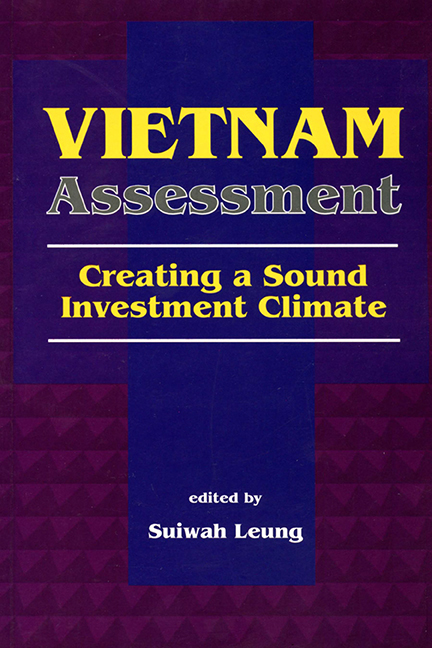Book contents
- Frontmatter
- Contents
- List of tables
- List of figures
- Foreword
- Contributors
- Acknowledgments
- 1 Introduction
- 2 Economic developments and prospects
- 3 Policy reform and the microeconomic environment in the agricultural sector
- 4 Politics of the reform of state institutions in the post-socialist era
- 5 Foreign direct investment in Vietnam
- 6 Foreign investors in Vietnam: An Australian case study
- 7 Providing legal services in Vietnam: A practitioner's viewpoint
- Index
- About the Editor
5 - Foreign direct investment in Vietnam
Published online by Cambridge University Press: 21 October 2015
- Frontmatter
- Contents
- List of tables
- List of figures
- Foreword
- Contributors
- Acknowledgments
- 1 Introduction
- 2 Economic developments and prospects
- 3 Policy reform and the microeconomic environment in the agricultural sector
- 4 Politics of the reform of state institutions in the post-socialist era
- 5 Foreign direct investment in Vietnam
- 6 Foreign investors in Vietnam: An Australian case study
- 7 Providing legal services in Vietnam: A practitioner's viewpoint
- Index
- About the Editor
Summary
The growing share of foreign direct investment (FDI) in total net resource flows to developing countries has revived interest in the costs and benefits arising from foreign investment. The flow of FDI to developing countries in 1988 was US$19 billion; this was more than four times the total commercial lending of US$4.7 billion to these countries. By 1991, the amount had risen to US$35.9 billion. The share of FDI in total net capital flows into developing countries rose from 12% in 1987 to 37% in 1994 (UNCTAD 1995).
The strength of economic growth and stability in Southeast Asian economies over the past two decades has demonstrated that outward-looking strategies, including foreign trade and investment policies, contribute to strong economic performance. FDI generates much-needed capital inflows and other substantial benefits, including the transfer of technology and labour skills, better use of idle resources and improved access to export markets. Developing countries now not only encourage FDI, but actively compete for it by removing regulations and offering incentives to foreign firms.
Recognising the important role that FDI can play in developing a viable economy, the Vietnamese government promulgated a new Foreign Investment Law in 1987. It has since taken other steps to create a more attractive environment for foreign investment. In 1990, the law was amended to permit economic organisations in the private sector to engage in direct cooperation and investment with foreign organisations and individuals. It was amended again in December 1992 to create a more competitive environment for attracting foreign investment. In the eight years since the implementation of the Foreign Investment Law, capital inflows have increased significantly.
Vietnam's foreign investment policy
Investment incentives granted by host governments to foreign investors can be effective in influencing the location choices of foreign firms (Guisinger 1985). In this section, I compare Vietnam's foreign investment policies with those of other Asian developing countries, particularly Indonesia, considered to be a major competitor (Cuong 1993).
- Type
- Chapter
- Information
- Vietnam AssessmentCreating a Sound Investment Climate, pp. 69 - 89Publisher: ISEAS–Yusof Ishak InstitutePrint publication year: 2000

